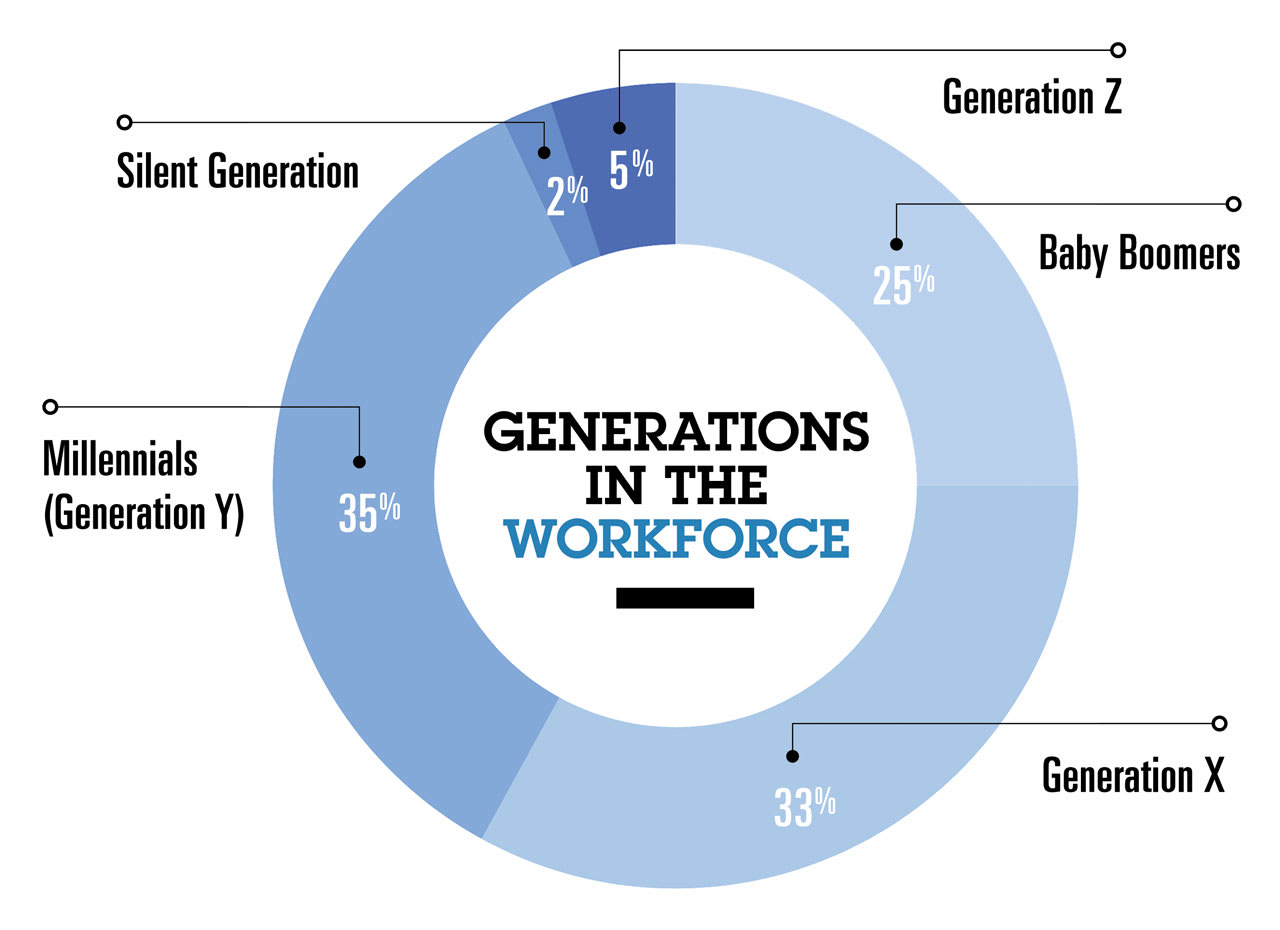For the first time in history, we have up to five generations working together. Specifically, employees may range from the Silent Generation (born 1928 to 1945) all the way to Generation Z (born 1997 to 2012), with baby boomers (1946 to 1964), Generation X (1965 to 1980) and millennials (1981 to 1996) in between. For many, a multigenerational workforce can be a challenge to manage effectively. Clashing norms and different generational perspectives — just one part of one’s personality — often lead to tension, but hidden amongst the generational differences is a significant opportunity for learning and collaboration.

Understanding generations
As a generation matures, it undergoes unique experiences, gains specific knowledge, and encounters distinct opportunities during its formative years, distinguishing it from the generations that came before and come after.
The collective experiences of a generation give rise to a phenomenon known as a “peer personality” — a narrative embodying an age cohort shaped by the collective experience of significant events at common life stages. For example, our youngest employees, Generation Z, all experienced the pandemic during their most formative years. This “peer personality” can create similar norms within generational groups, fostering a sense of unity and cohesion among its members.
While generational identity is just one facet of an individual (see above), with its influence varying significantly from person to person, acknowledging generational identity is an important aspect of understanding individuals in a work setting. Generational differences in norms and perspectives can result in conflict and misunderstanding, and being willing to take a step back to understand why different generations may be viewing a work-related issue differently is key to making sure all generations in the workplace feel seen, respected, and understood. Without
this, we are likely to see higher levels of turnover and employee disengagement.
Action step in the optometry practice. “To make sure all members of my staff feel seen, respected, and understood, regardless of their generation or personality as a whole, I try to reach out and ask each one of them for their input,” explains April Jasper, OD, chief optometric editor of Optometric Management magazine.
One way she says she has done this is in the past is to take her staff on an excursion to a local mall, give them money to shop at specific stores, and then report back on their customer experiences at each store. Next, they must answer specific pre-determined questions to enable them to learn from experience and then together brainstorm ways to implement similar positive customer experiences at the practice.

Understanding the opportunities
Without a proactive strategy, generational differences can negatively impact staff retention, team cohesion, and even job performance. However, if we are able to create workplace cultures that focus on intergenerational understanding and collaborations, these challenges can be transformed into benefits. A multigenerational workforce brings with it a wide range of expertise, diverse experiences, and diversity of thought and perspective. I recommend using “Gentelligence,” or the workplace strategy of tapping into the potential of intergenerational learning and collaboration. To obtain “Gentelligence,” one must follow these four practices:
1. Identify assumptions. Be cautious about relying on generational myths (e.g., baby boomers don’t embrace new technology) and stereotypes (e.g., generation Z lacks work ethic). Understanding differences in generational norms and preferences can be a great starting point for deeper discussions (see below), but sweeping generalizations aren’t the answer. Practice managers and/or owners need to ensure that they and their multigenerational staff members don’t assume that all generations see work-related items the same way.
As a general and recent example, “work flexibility” is a phrase that tends to be interpreted based on generational identity. For a baby boomer who spent five days a week (or more) in the office for most of their career, coming in 3 days a week might seem very flexible. For a Generation Z employee who began their career entirely remote, a 3-day-a-week office schedule might seem relatively rigid.
The bottom line: I suggest thinking: “What other workplace issues might I be assuming employees of different generations view the same as I do, and where might important generational differences be important to consider?”
2. Adjust the lens. It’s human nature to judge things that are different as wrong. In the case of generational differences, this happens most often when we react to attitudes and/or behaviors that don’t align with our views of what is appropriate in the workplace. Adjusting the lens means seeking to identify the intent and interest behind these actions rather than jumping to judgement.
Research shows that people tend to have similar intrinsic needs in the workplace (such as the need for respect or connection) but may have learned different approaches as the generational norms surrounding how to fill those needs shifted over time. So, whereas baby boomers learned to earn respect in the workplace by putting their heads down, working hard and waiting for their turn for a promotion, the millennial generation often puts themselves in front of the best opportunities before someone else does. In both cases, the individual’s intent is to earn respect, and recognizing that common ground can be a great starting point to build connections and understanding.
Action step in the optometry practice. “One way to focus on intent vs. behavior is use of sick days. Specifically, I’ve noted that the older generation tends to use sick days as a last resort; pushing through colds and such because their intent is to show they have a good work ethic,” notes Dr. Jasper. “The younger generation tends to use sick days less sparingly because their intent is to prioritize their health over work. When looking at intent from both perspectives, neither is wrong, they are just different.”
3. Strengthen trust. Successful teams are built on collective trust and connection among their team members. When teams are comprised of members who have significant age differences, that trust can sometimes be challenging to establish. The reason: “Peer personality” described above, or the similarity effect. In other words, people tend to gravitate toward people they perceive as “like me” in meaningful ways, including age and generation. This age polarization can result in a hesitancy to share ideas, ask for help, or provide counter opinions in a team environment, all of which can impact team cohesion, effectiveness, and job engagement. To build this trust, employees of all ages must believe their organization cares about their different needs, supports their growth, and sees the unique ways they can add value.
Action step in the optometry practice. To show her employees that she cares about their “different needs, supports their growth, and sees the unique ways they can add value,” Dr. Jasper says she always gets staff input about any changes being considered in practice policy.
“If I’m thinking about making any adjustments to practice policy, like the way in which contact lenses are ordered, as an example, I talk to those who are going to be directly affected by the adjustment to get their thoughts on it,” she explains. “Once the adjustment or protocol is put in place, I also follow up with staff to get their input on how it’s going.”
4. Expand the pie. Solving the tough challenges in today’s workplaces requires collective efforts. Organizations benefit from the combination of both fresh perspectives and seasoned experience, necessitating a successful integration of the two.
Practice managers and/or owners must champion a mindset that recognizes various generations’ diverse experiences and expertise as essential for the innovation and adaptability demanded by the future. The shift is from a win-lose mentality to one that underscores the advantages of collaborative efforts for mutual benefit. By seeing expertise and experiences as complementary rather than competitive, practice managers and/or owners and multigenerational staff members can approach generational differences as a unique form of talent diversity.
Action step in the optometry practice. To illustrate the advantages of a multigenerational staff and how it is complementary vs. competitive, Dr. Jasper starts every staff meeting with an activity that accomplishes just that.
“Each staff member picks a number out of a bowl. Each of these numbers correspond to a specific staff member. Once everyone has their number, they must tell the rest of the staff why they think the staff member they picked out of the bowl is awesome,” she offers. “This activity reveals each staff member’s strongest attribute and how it has made the practice successful.”
Feeling valued and heard
Through a “Gentelligence” approach, practice managers and/or owners can create cultures that normalize mutual generational respect; workplaces where people across life and career stages feel valued and heard. While we don’t know what challenges lie ahead in work, we will need the insights of all generations to navigate them successfully. OM




